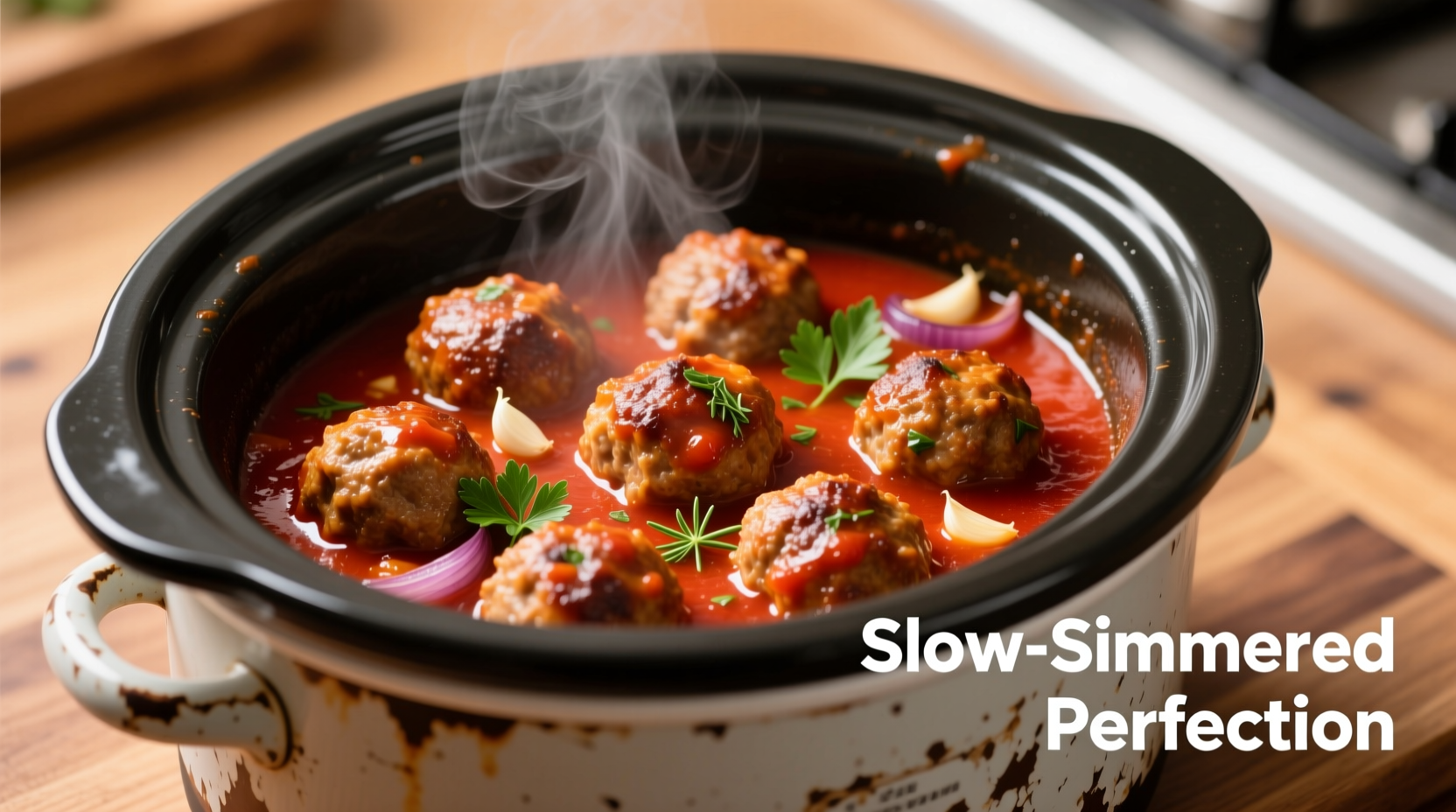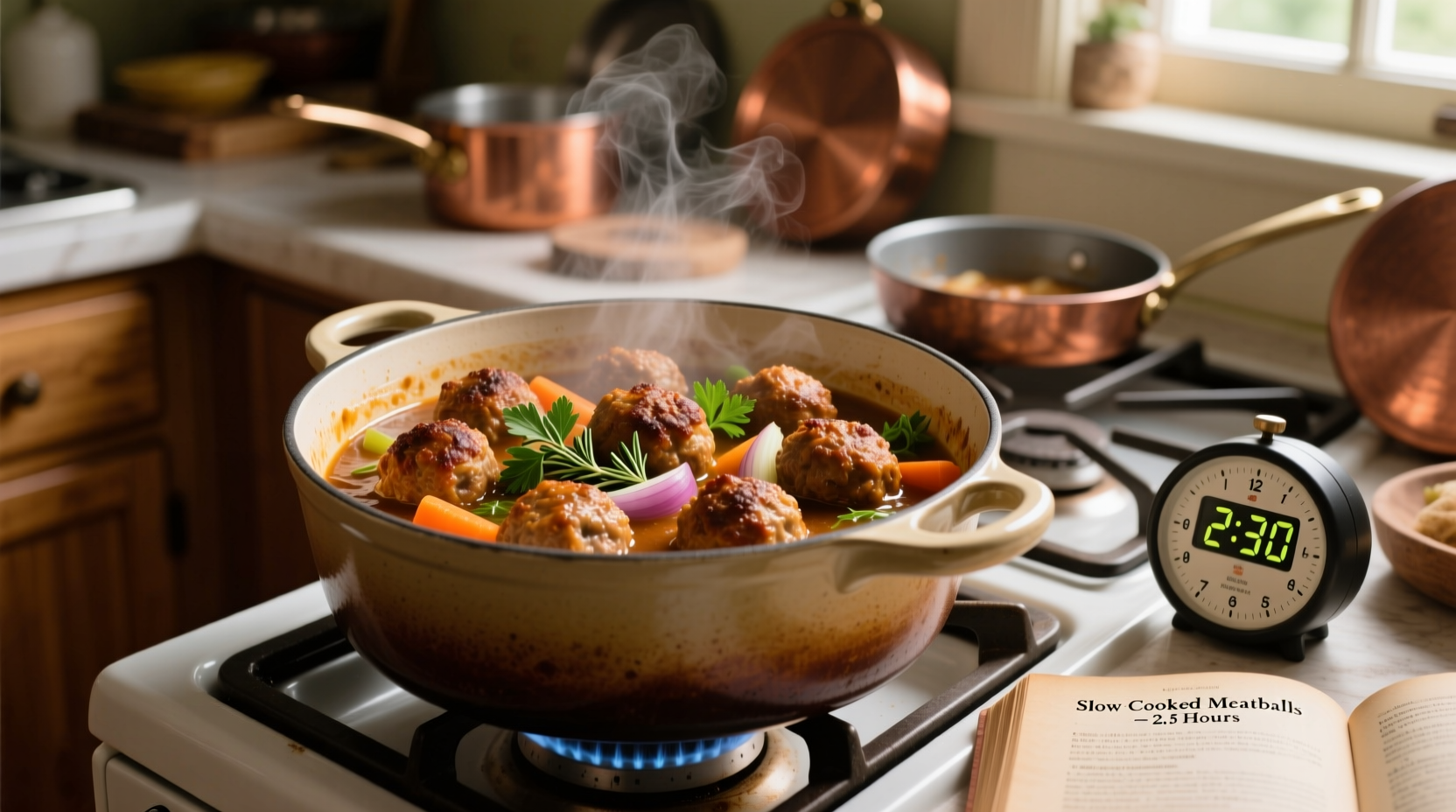Ever pulled apart disappointing meatballs that fell apart or tasted dry after hours in your slow cooker? Getting the timing right transforms this classic comfort food from mediocre to magnificent. This guide delivers precise cooking times based on professional chef techniques and food science principles—so you'll consistently create tender, flavorful meatballs that hold their shape and satisfy every bite.
Standard Slow Cooking Times for Meatballs
The ideal cooking duration depends primarily on your slow cooker's heat setting and meatball size. Here's what experienced chefs recommend for optimal texture and safety:
| Slow Cooker Setting | Standard Meatballs (1.5-inch) | Large Meatballs (2-inch+) | Critical Safety Check |
|---|---|---|---|
| HIGH | 3-4 hours | 4-5 hours | 160°F internal temperature |
| LOW | 6-8 hours | 8-10 hours | 160°F internal temperature |
This time-temperature relationship comes directly from USDA Food Safety and Inspection Service guidelines, which mandate 160°F as the minimum safe internal temperature for ground meats to eliminate harmful bacteria. Many home cooks mistakenly rely solely on time without verifying temperature, risking foodborne illness.
Key Factors That Change Cooking Time
Understanding these variables prevents undercooked or overcooked results:
Meat Composition Matters
Different meats require varied attention. Beef and pork combinations maintain structure better during extended cooking, while turkey and chicken meatballs become dry faster. As Colorado State University Extension notes, lean meats like turkey need closer monitoring as they reach the danger zone (40-140°F) more quickly during the warm-up phase.
Sauce Coverage Is Crucial
Meatballs fully submerged in sauce cook more evenly than those partially exposed. The liquid creates a consistent thermal environment, preventing the tops from drying out. Always ensure sauce covers at least two-thirds of each meatball for uniform results.
Frozen vs. Fresh Starting Point
Adding frozen meatballs extends cooking time by 1-2 hours. Never place frozen meatballs directly in a slow cooker without adjusting time—this keeps them in the bacterial danger zone too long. Thaw completely in the refrigerator first for safest results.

Step-by-Step Process for Foolproof Results
Follow this chef-tested sequence for meatballs that hold together and deliver maximum flavor:
Preparation Phase (15 minutes)
Brown meatballs in a skillet before transferring to the slow cooker. This critical step, recommended by culinary professionals, creates a protective crust that maintains structure during slow cooking. Don't skip this—even if recipes claim it's unnecessary. The Maillard reaction developed during browning significantly enhances flavor complexity.
Cooking Timeline Checkpoints
- Hour 2 (HIGH) / Hour 4 (LOW): Gently stir to prevent sticking. Check sauce level—add ¼ cup broth if drying out.
- Hour 3 (HIGH) / Hour 6 (LOW): Insert thermometer into center of largest meatball. Should register at least 150°F.
- Hour 3.5 (HIGH) / Hour 7 (LOW): Final temperature check. Remove immediately when reaching 160°F.
Avoid These Common Mistakes
Professional chefs consistently identify these errors that ruin slow-cooked meatballs:
Overfilling the Slow Cooker
Crowding prevents even heat distribution. Never fill beyond two-thirds capacity. For large batches, cook in multiple batches or use a larger appliance. The National Center for Home Food Preservation confirms overcrowding creates uneven cooking zones that compromise food safety.
Skipping the Rest Period
Let meatballs rest in the turned-off slow cooker for 15 minutes before serving. This allows juices to redistribute and proteins to relax, preventing dryness when cut. Many home cooks serve immediately, losing precious moisture.
Advanced Techniques for Restaurant-Quality Results
Elevate your meatballs with these professional chef secrets:
Temperature-Controlled Finish
When meatballs reach 155°F, turn off the slow cooker and let residual heat bring them to 160°F. This prevents overshooting the target temperature, which causes dryness. The FDA's Food Code specifies this precision approach for optimal food safety and quality.
Sauce Integration Method
Add half your sauce at the beginning, then stir in the remaining sauce during the last hour. This preserves fresh tomato flavor while allowing sufficient time for flavor melding. Acidic ingredients break down over extended cooking, so timing matters for balanced taste.
Troubleshooting Guide
Solve these common issues with targeted solutions:
Meatballs Falling Apart
Cause: Insufficient binder or overfilling the slow cooker. Solution: Use ¼ cup breadcrumbs per pound of meat and avoid stirring aggressively. The American Egg Board recommends one egg per pound of meat as the ideal binder ratio for structure without dryness.
Dry or Tough Texture
Cause: Overcooking or lean meat mixture. Solution: Reduce cooking time by 30-60 minutes next batch and incorporate 2 tablespoons olive oil into the meat mixture. Proper fat content (15-20%) is essential for moisture retention during slow cooking.











 浙公网安备
33010002000092号
浙公网安备
33010002000092号 浙B2-20120091-4
浙B2-20120091-4